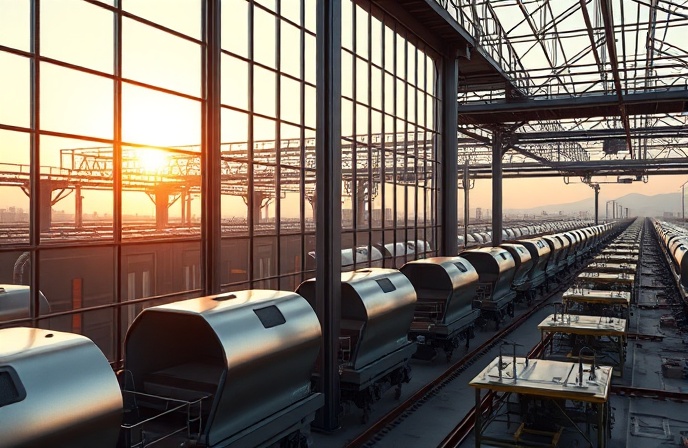Essential Railway Maintenance Guide: Inspections & Advancements
“Keep rolling with expert railway maintenance. From inspections to predictive maintenance, we’ll explore how to optimize safety, efficiency, and the lifespan of your assets. Learn the secrets! “

Examining the Core of Railway Maintenance: A Comprehensive Overview
The railway industry, a cornerstone of global transportation, relies heavily on the diligent maintenance of its rolling stock to ensure safety, efficiency, and longevity. This article delves into the critical aspects of railway maintenance, exploring the various facets that contribute to the smooth operation of rail networks worldwide. From scheduled inspections and preventative measures to the complex overhauls required to keep trains operational, we will analyze the methodologies, technological advancements, and logistical considerations that define the modern railway maintenance landscape. Our exploration will cover key areas such as inspection techniques, the importance of predictive maintenance, and the significance of specialized facilities in keeping railway systems running at peak performance. The objective is to provide a holistic understanding of the challenges and innovations in railway maintenance.
The Vital Role of Inspection and Preventative Maintenance
The foundation of a robust railway maintenance program rests upon thorough inspection and proactive preventative measures. Regular inspections are crucial for identifying potential issues before they escalate into major failures, ensuring the safety of passengers and minimizing service disruptions. These inspections encompass a range of techniques, from visual examinations of components such as wheels, brakes, and couplers to advanced non-destructive testing (NDT) methods. NDT techniques, including ultrasonic testing, eddy current testing, and magnetic particle inspection, allow technicians to detect internal flaws and stresses within the railcar components without disassembling them. The frequency of these inspections is typically determined by factors such as the type of rolling stock, operating conditions, and regulatory requirements.
Preventative maintenance involves scheduled servicing and component replacements based on time, mileage, or operating hours. This proactive approach helps to mitigate the risk of unexpected breakdowns and extends the lifespan of critical equipment. Lubrication, filter changes, and brake pad replacements are examples of standard preventative maintenance tasks. Furthermore, adopting condition-based maintenance (CBM) strategies, which utilize data from sensors and monitoring systems to assess the actual condition of components, can optimize maintenance schedules and reduce unnecessary interventions.
You might be interested in:
Predictive Maintenance and Data Analytics
The evolution of railway maintenance is inextricably linked to the rise of predictive maintenance strategies and data analytics. Predictive maintenance goes beyond preventative measures by utilizing data collected from various sources to forecast potential failures and optimize maintenance schedules. Sensors installed on trains and trackside infrastructure continuously monitor key parameters such as temperature, vibration, and pressure, providing real-time insights into the health of the rolling stock. This data is then analyzed using advanced algorithms and machine learning techniques to identify patterns and anomalies that may indicate an impending failure.
The implementation of predictive maintenance offers significant advantages, including reduced downtime, optimized maintenance costs, and enhanced safety. By anticipating failures, maintenance teams can proactively schedule repairs, minimizing disruptions to service and preventing catastrophic incidents. Data analytics also enables railway operators to identify trends and root causes of failures, allowing for targeted improvements in design, manufacturing, and operating practices. The integration of digital twins – virtual replicas of physical assets – further enhances predictive capabilities by simulating the performance of components under various operating conditions and predicting their remaining useful life.
The Significance of Specialized Maintenance Facilities
Specialized maintenance facilities are indispensable for the effective maintenance of railway rolling stock. These facilities, often referred to as railcar service center Estonia (as an example), are equipped with specialized tools, equipment, and skilled personnel required for performing a wide range of maintenance tasks, from routine inspections to complex overhauls. The layout and design of these facilities are carefully planned to optimize workflow and ensure efficiency.
Key features of a modern maintenance facility include inspection pits, lifting jacks, wheel lathes, and specialized workshops for various components such as bogies, brakes, and electrical systems. Heavy lifting equipment, such as cranes and overhead gantries, is essential for handling large components. Additionally, these facilities are equipped with advanced diagnostic tools and testing equipment to accurately assess the condition of rolling stock. The personnel working at these facilities are highly trained technicians and engineers with expertise in various aspects of railway maintenance. They are responsible for performing inspections, repairs, and overhauls to the highest standards, ensuring the safety and reliability of the railway fleet.
In addition to maintenance activities, these facilities often serve as a hub for spare parts management, inventory control, and training. This integrated approach to maintenance ensures that the railway system operates smoothly and efficiently.
Conclusion: Charting the Course for a Sustainable Railway Future
In summary, the maintenance of railway rolling stock is a multifaceted endeavor that requires a combination of meticulous inspection, proactive preventative measures, and the strategic implementation of predictive maintenance technologies. From routine checks and timely component replacements to the sophisticated analysis of data, every aspect contributes to the safety, reliability, and efficiency of rail networks. The evolution of maintenance practices, driven by advancements in technology and data analytics, has empowered railway operators to optimize their maintenance schedules, reduce downtime, and extend the lifespan of their assets. The importance of specialized maintenance facilities, such as the railcar service center Estonia, and their role in providing the infrastructure, expertise, and resources necessary for complex repairs and overhauls, cannot be overstated.
The future of railway maintenance is inextricably linked to the continued integration of digital technologies, the adoption of data-driven decision-making, and the pursuit of sustainable practices. By embracing innovations such as predictive maintenance, digital twins, and advanced materials, the railway industry can further enhance its ability to provide safe, reliable, and environmentally friendly transportation services. The ongoing investment in research and development, combined with the training of a skilled workforce, will be crucial for ensuring the long-term viability and success of the railway sector. As the demand for efficient and sustainable transportation continues to grow, the importance of effective railway maintenance will only become more pronounced.





